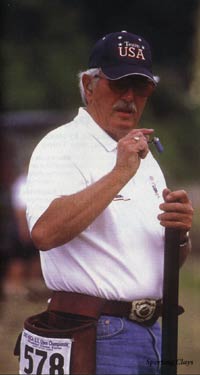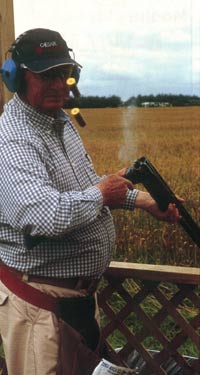
| Article for Sporting Clays Magazine - November 2003 |
| The Magic Pill by Chris Batha |
| continued from previous page... |
|
|
 |
| By carefully mating quality target loads with effective even-patterning chokes, the studied shotgunner can deliver clays-busting shot clouds downrange with confidence. |
The
question I am most asked by shotgunning clients relates to the subject
of chokes and cartridges. There seems to be a belief that there
is a magic formula of the two that, when discovered, can propel
the clays competitor into a higher class, help win a tournament,
or overcome inadequacies in their fundamental shooting skills. In
effect, they are looking for a magic pill that does not exist and
can be compared to the Middle Ages alchemist's obsession with attempting
to turn lead into gold. You can have the finest combination of choke
and cartridge, but unless you place the shot string onn line and
in front of the target, it will not help you one bit. So, first, I would like you to answer the following questions: Are your target breaks chips or breaks around the edges of clays, or are they balls of dust? If safe to do so, can you collect complete missed targets and see if there are any holes in them? Do you shoot different disciplines with the same gun? Do you miss more than you hit? Do you shoot a fixed-choke gun? If one or more of your answers where "yes," then a better understanding of choke and cartridge choice could definitely improve your scores. Let's begin with a brief history of choke and how its introduction resulted in changes over the years in both barrel and cartridge design. Before the invention of choke, all barrels where simply straight tubes (hence the expression "true cylinder") with an effective killing range of under 30 yards, with 25 being the norm. Anything hit beyond these ranges was a matter of luck. The contested invention of shotgun choke between W. R. Pape, an Englishman, in 1866, and American Fred Kimble in 1870 was followed by W.W. Greener's research and development. Regardless, this key element of ballistics did more to increase the effective range of the shotgun than any invention since. It effectively changed the shotgun from a range of 30 yards to one of 50 yards. Since choke's major impact on range and effectiveness was recognized, it has been experimented with for the last 150 years to squeeze from it every last advantage of terminal ballistics. What IS Choke? To choke shot pellets means to constrict them with a tightening effect. The walls of the shotgun barrel are parallel, with the inside diameter at the muzzles becoming smaller. The amount of constriction is measured in thousands of an inch as compared to the nominal boring of the barrel. Ranging from the least degree of constriction to the greatest, there is a handful of major designations, these often measured in 10th inch increments and begin at true cylinder, where the barrels have no choke present. Terminology And Sizes Different countries have differing terminology for the amount of choke present in a barrel, and that's where much of the confusion with chokes arises. Designated names and measurements in inches are used, and often with not much consistency. Generally, though, true cylinder offers no constriction, improved cylinder (or quarter choke) is .010", modified (half choke) .020", improved modified (three-quarter choke) .030", and full .040" choke. There are even choke constrictions designed for specific disciplines, such as "skeet" choke. Each manufacturer seems to have its own personal interpretation of what this amount should be, anywhere from .005" to .008" constriction. Add to the fray "spreader" or "diffusion" chokes, plus how back-bored or over-bored barrels affect choke dimensions/designations, and the need for careful inspection and the use of a patterning board becomes evident--at least to the shotgunner who wants to know for sure how his loads pattern from his shotgun through a given choke. |
Range And Distance The function of choke is to increase the effective
range of the shotgun. It achieves this by holding the shot charge
closer together by reducing the amount of spreading once the pellets
leave the barrel. Again, as a general guide, the optimum range of
the various chokes is as follows:
Page 1 |
